 First grade just finished their clay owls. For the full tutorial click here.
First grade just finished their clay owls. For the full tutorial click here.Thursday, December 23, 2010
Klimt's Tree of Life
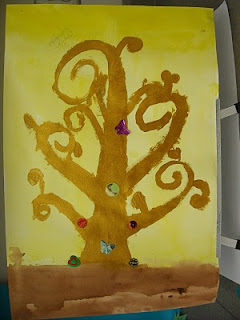 My second graders just finished paintings inspired by Gustav Klimt's Tree of Life. They started by painting a watercolor wash for the background, yellow on most of it with a little bit of brown on the bottom. Next class, we drew the tree together. On the SmartBoard I showed them Klimt's painting and drew on it, emphasizing the Y shape where the tree branches split from the trunk and the way the trunk and branches get skinnier as they move away from the base of the tree.
My second graders just finished paintings inspired by Gustav Klimt's Tree of Life. They started by painting a watercolor wash for the background, yellow on most of it with a little bit of brown on the bottom. Next class, we drew the tree together. On the SmartBoard I showed them Klimt's painting and drew on it, emphasizing the Y shape where the tree branches split from the trunk and the way the trunk and branches get skinnier as they move away from the base of the tree. 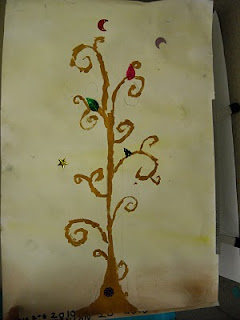 Once the trees were drawn I showed them how to choose paint brushes based on the needs of their painting. I told them to get a medium sized flat brush and a small round tip brush and showed them how to move the brush from side to side to create a very crisp line with their paint. They took the painting part very seriously, it was actually silent in the room for a while they were so focused!
Once the trees were drawn I showed them how to choose paint brushes based on the needs of their painting. I told them to get a medium sized flat brush and a small round tip brush and showed them how to move the brush from side to side to create a very crisp line with their paint. They took the painting part very seriously, it was actually silent in the room for a while they were so focused!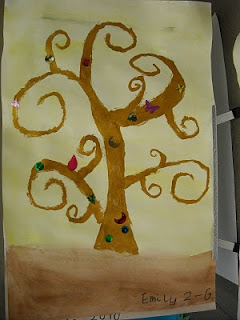 The final step was to add a few sequins to imitate Klimt's patterns. If I had it to do over (which I do, next year!), I would order sequins that are only circular and/or square. The kids got a bit too focused on the different shapes and lost their focus on their patterns.
The final step was to add a few sequins to imitate Klimt's patterns. If I had it to do over (which I do, next year!), I would order sequins that are only circular and/or square. The kids got a bit too focused on the different shapes and lost their focus on their patterns.Wednesday, December 22, 2010
Thinking in Pictures
One of my inspirations in my research on the minds of people with Autism is Temple Grandin. She has a couple of books published, one is called "Thinking in Pictures." As an adult with Autism, she writes about how her mind works and how others with Autism think. There was recently an HBO movie made about her, starring Claire Danes (which I hope to watch over break, if my kids will nap at the same time for me). I found this video clip of her speaking at a TED function via The Art Teacher's Guide to the Internet. The video is a little long-20 minutes, but will give you a sample of what she talks about in her book, and I assume her movie. If you're interested in how children on the Autism Spectrum think it's a good place to start.
70 Million by Hold Your Horses ! from L'Ogre on Vimeo.
Tuesday, December 21, 2010
TR Mack-Results
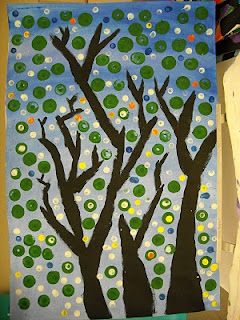 Some of my fourth graders have completed their TR Mack projects. I must admit, that in general I was quite disappointed in the results. A lot of the children did not have the patience required to strategically place the circles around their tree branches. There were, of course a few gems in the bunch. These three are my personal favs. These three artists really worked hard to complete their artwork, and took all of my instructions to heart.
Some of my fourth graders have completed their TR Mack projects. I must admit, that in general I was quite disappointed in the results. A lot of the children did not have the patience required to strategically place the circles around their tree branches. There were, of course a few gems in the bunch. These three are my personal favs. These three artists really worked hard to complete their artwork, and took all of my instructions to heart. 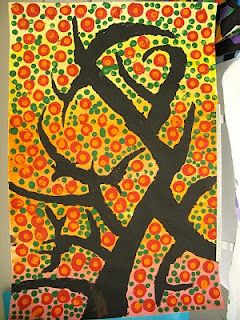 At my other school, we voted on the circles and both classes decided that they did not want to add them. So, if you want to see our Artsonia gallery without circles you can click here.
At my other school, we voted on the circles and both classes decided that they did not want to add them. So, if you want to see our Artsonia gallery without circles you can click here.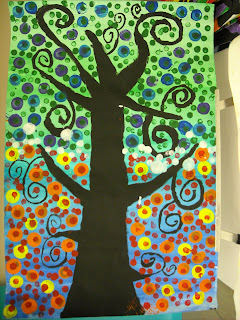
Wednesday, November 17, 2010
Shutterfly
Anyway, if you are in the market for an online photography service now is a great time to try Shutterfly. They are currently running a program just for bloggers! Sign up here, post a blog, post on FB or Twitter and get 50 FREE cards! I am hoping to get all of my Christmas cards done with this program!
Monday, November 15, 2010
Action Research
Thursday, November 11, 2010
TR Mack
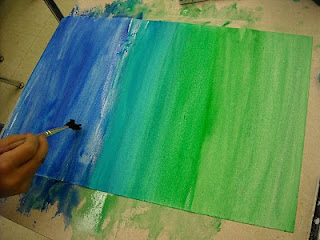
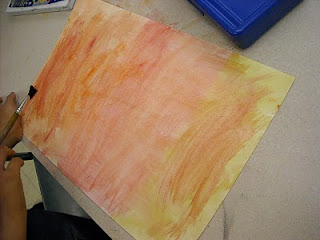

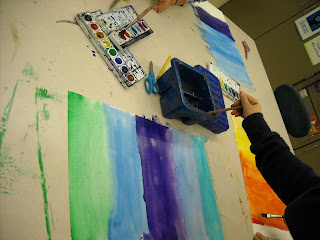
Here is my in-progress and completed examples of this project. I can't wait to see them finished!
Thanks, Ms. Malone for the heads up on a wonderful artist!
Thursday, September 30, 2010
What We're Doing
 They just finished their "Kindergarten Kandinsky" projects. We identified shapes and colors in Kandinsky's paintings, and then drew shapes with oil pastels. Next class we watercolored over them.
They just finished their "Kindergarten Kandinsky" projects. We identified shapes and colors in Kandinsky's paintings, and then drew shapes with oil pastels. Next class we watercolored over them. I can. . .
- recognize shapes in Kandinsky's art
- use oil pastels to draw shapes
- use good painting techniques
FIRST GRADE


 They are creating awesome Laurel Burch Cats, found here. If you're interested in doing it, feel free to use my Prezi, which is here.
They are creating awesome Laurel Burch Cats, found here. If you're interested in doing it, feel free to use my Prezi, which is here. Wow! Finally one I haven't already blogged about! My fourth graders started with "Name Fish." A pretty traditional lesson, I think. I start by telling them it's an IMAGINARY fish. They are asked to draw a fish, add thier name in bubble letters on the body, and use value in every section of the fish with colored pencils. Those are their Learning Targets too.
Wow! Finally one I haven't already blogged about! My fourth graders started with "Name Fish." A pretty traditional lesson, I think. I start by telling them it's an IMAGINARY fish. They are asked to draw a fish, add thier name in bubble letters on the body, and use value in every section of the fish with colored pencils. Those are their Learning Targets too.Bubble Paintings
 Then they simply lay their paper over the bubbles, popping the bubbles and leaving a print where the bubble popped. Layering the colors makes for a beautiful pastel image.
Then they simply lay their paper over the bubbles, popping the bubbles and leaving a print where the bubble popped. Layering the colors makes for a beautiful pastel image.Monday, September 27, 2010
Pinwheels for Peace
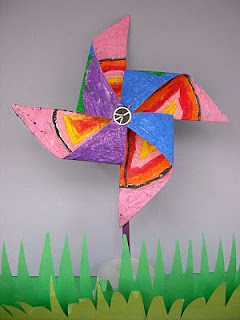 September 21st is the International Day of Peace. I asked the classroom teachers to bring their class outside on that day and "Plant" their pinwheels somewhere around the school. At one school we focused the pinwheels around the school sign and at the other we put them all the way around the school.
September 21st is the International Day of Peace. I asked the classroom teachers to bring their class outside on that day and "Plant" their pinwheels somewhere around the school. At one school we focused the pinwheels around the school sign and at the other we put them all the way around the school. At the end of the day we had an all-school meeting (our name for an assembly) outside where we brought it all together. The school that planted them around the building created a parade around the school to check out all of the pinwheels, then walked around a second time to pick their pinwheel and take them home.
At the end of the day we had an all-school meeting (our name for an assembly) outside where we brought it all together. The school that planted them around the building created a parade around the school to check out all of the pinwheels, then walked around a second time to pick their pinwheel and take them home. It turned out great. EVERY pinwheel worked!
It turned out great. EVERY pinwheel worked! I was a little nervous to do it with the kinders. The thought of giving them scissors on their very first visit to me made me cringe a little. It turned out great though! And now I know that all of them can handle scissors. If you're interested in participating in this project next year, you can print off the template at the Pinwheels for Peace website.
I was a little nervous to do it with the kinders. The thought of giving them scissors on their very first visit to me made me cringe a little. It turned out great though! And now I know that all of them can handle scissors. If you're interested in participating in this project next year, you can print off the template at the Pinwheels for Peace website.Saturday, September 25, 2010
It Stuck!
Friday, September 24, 2010
Organization

An example of "table folders."
 "Class folders" simply have the grade and teacher's name on the outside of the folder.
"Class folders" simply have the grade and teacher's name on the outside of the folder.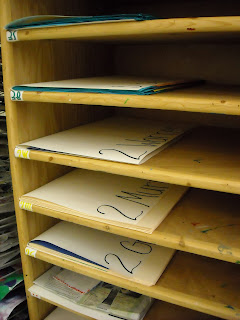 I also like to have a spot for everything, and everything in it's spot. I am constantly reminding students to put things exactly where they belong, or we won't be able to find them when we need them later. I have labeled every cabinet, drawer, and container with photo labels so even the children that don't read yet can figure out where to put whatever supply they have.
I also like to have a spot for everything, and everything in it's spot. I am constantly reminding students to put things exactly where they belong, or we won't be able to find them when we need them later. I have labeled every cabinet, drawer, and container with photo labels so even the children that don't read yet can figure out where to put whatever supply they have.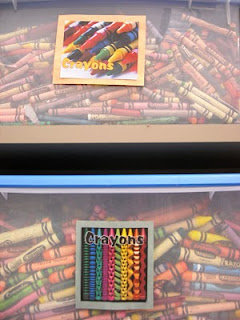 I also have a helper table each class period. We work on a six day cycle, so I change the color of a piece of paper on my white board every Day 1. The paper represents which table is my helper table.
I also have a helper table each class period. We work on a six day cycle, so I change the color of a piece of paper on my white board every Day 1. The paper represents which table is my helper table.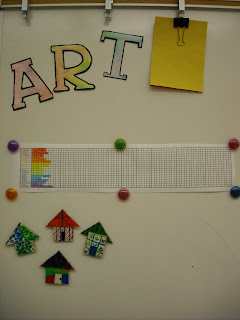 I have magnetic letters that spell "ART" on my whiteboard as well. When a class is off task, I will move a letter to the other side of the board. If all three letters are moved, they must be silent for the rest of that art period.
I have magnetic letters that spell "ART" on my whiteboard as well. When a class is off task, I will move a letter to the other side of the board. If all three letters are moved, they must be silent for the rest of that art period. For every letter that remains in it's original spot for the whole art class, I color a square on my chart. When the colored blocks reach the dark line the students get a treat. Last year I let them sit wherever they wanted for a class, which is a great treat for them but completely messes up my organization! This year I have a bucket of candy, plastic rings, and pencil grips.
For every letter that remains in it's original spot for the whole art class, I color a square on my chart. When the colored blocks reach the dark line the students get a treat. Last year I let them sit wherever they wanted for a class, which is a great treat for them but completely messes up my organization! This year I have a bucket of candy, plastic rings, and pencil grips. For better or worse, there is a Yakker Trakker in my room. I like the concept, but find that they settings are either too sensitive or not sensitive enough. If the light goes to red an alarm goes off and a magnetic letter is automatically moved. I make it clear, however that a letter can be moved without the alarm going off too.
For better or worse, there is a Yakker Trakker in my room. I like the concept, but find that they settings are either too sensitive or not sensitive enough. If the light goes to red an alarm goes off and a magnetic letter is automatically moved. I make it clear, however that a letter can be moved without the alarm going off too. Tuesday, September 14, 2010
Art Room Laugh
Saturday, September 11, 2010
Jackson Pollock
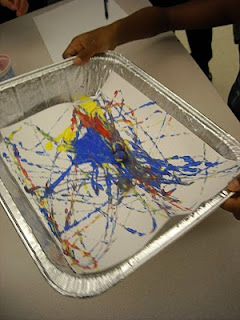 Once they mastered the marbles in pans we started working bigger. Another teacher donated a hard plastic pool and I brought in some tennis balls to create the same effect on a larger scale. Throughout the course of the art class, students worked on both fine and gross motor skills.
Once they mastered the marbles in pans we started working bigger. Another teacher donated a hard plastic pool and I brought in some tennis balls to create the same effect on a larger scale. Throughout the course of the art class, students worked on both fine and gross motor skills. 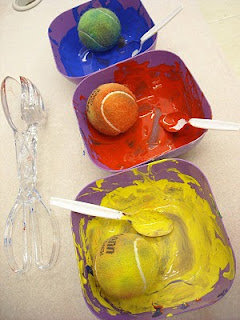 I brought salad tongs for the kids to work their dexterity while taking the balls out of the paint to put in the pool, and spoons to roll the balls in the paint.
I brought salad tongs for the kids to work their dexterity while taking the balls out of the paint to put in the pool, and spoons to roll the balls in the paint.More of my Classroom
 I have one bulletin board in my classroom (and one just outside of it). I use this board for the projects that all grades are working on. I find that the younger kids love looking forward to the projects the older kids are working on, and the older kids recall skills and terms that they learned previously when they see the younger kids working on them. This year I added my "Learning Tagets" near each project. Although not all of the kids can read them, it will also remind me to touch on those concepts during our discussions and assess learning on those items.
I have one bulletin board in my classroom (and one just outside of it). I use this board for the projects that all grades are working on. I find that the younger kids love looking forward to the projects the older kids are working on, and the older kids recall skills and terms that they learned previously when they see the younger kids working on them. This year I added my "Learning Tagets" near each project. Although not all of the kids can read them, it will also remind me to touch on those concepts during our discussions and assess learning on those items. Learning Targets are written using "I Can" statements, which I find really easy to write, and the kids find easy to evaluate.
Learning Targets are written using "I Can" statements, which I find really easy to write, and the kids find easy to evaluate.




















